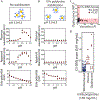Improving antibody drug development using bionanotechnology
- PMID: 34890875
- PMCID: PMC9356538
- DOI: 10.1016/j.copbio.2021.10.027
Improving antibody drug development using bionanotechnology
Abstract
Monoclonal antibodies are being used to treat a remarkable breadth of human disorders. Nevertheless, there are several key challenges at the earliest stages of antibody drug development that need to be addressed using simple and widely accessible methods, especially related to generating antibodies against membrane proteins and identifying antibody candidates with drug-like biophysical properties (high solubility and low viscosity). Here we highlight key bionanotechnologies for preparing functional and stable membrane proteins in diverse types of lipoparticles that are being used to improve antibody discovery and engineering efforts. We also highlight key bionanotechnologies for high-throughput and ultra-dilute screening of antibody biophysical properties during antibody discovery and optimization that are being used for identifying antibodies with superior combinations of in vitro (formulation) and in vivo (half-life) properties.
Copyright © 2021. Published by Elsevier Ltd.
Conflict of interest statement
Conflict of interest
None
Figures




References
Publication types
MeSH terms
Substances
Grants and funding
LinkOut - more resources
Full Text Sources

